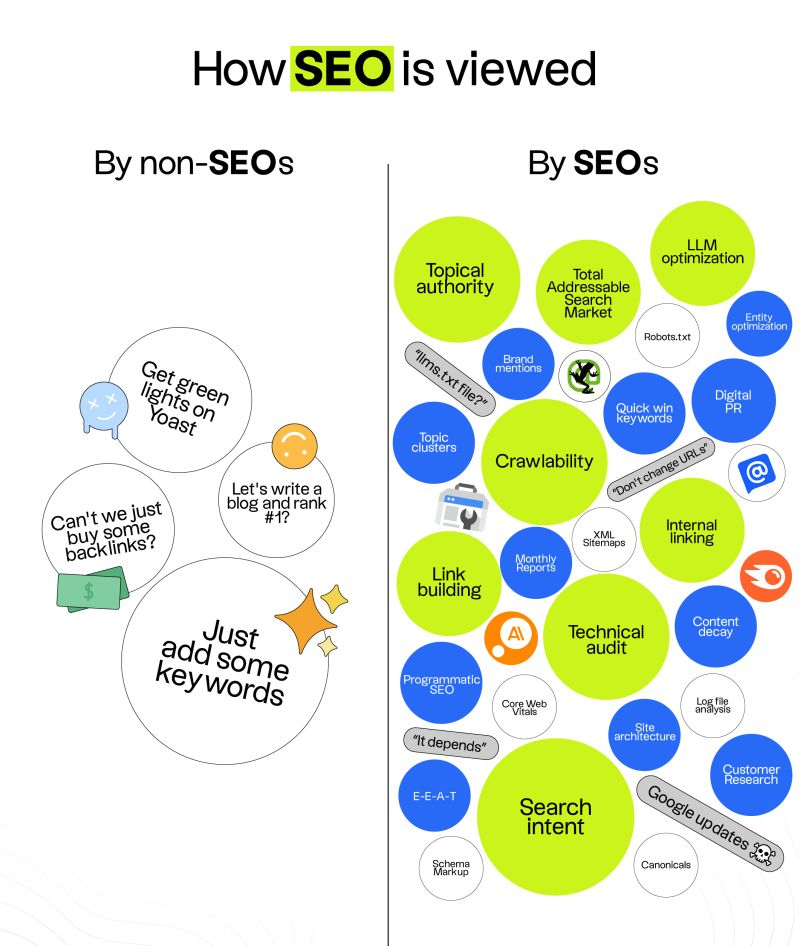SEO?
“Just add some keywords”
”Get green lights on Yoast”
”Let’s write a blog and rank #1?”
”Can’t we just buy some backlinks?”
But SEO in 2025 is a totally different beast.
Here’s what it actually involves:
- Total Addressable Search Market
- Google Search Console
- “Don’t change URLs”
- Quick win keywords
- Customer research
- Programmatic SEO
- Entity optimization
- LLM optimization
- Keyword Insights
- Topical authority
- Site architecture
- Schema markup
- Core Web Vitals
- Monthly reports
- Log file analysis
- Google updates
- Brand mentions
- Screaming Frog
- Technical audit
- Content decay
- Internal linking
- XML Sitemaps
- Topic clusters
- “llms.txt file?”
- Search intent
- Link building
- “It depends”
- Crawlability
- Canonicals
- Robots.txt
- Digital PR
- Mentions
- Semrush
- E-E-A-T
Just adding keywords or getting green lights on Yoast doesn't get SEO results.
True SEO and holistic marketing does.
“Just add some keywords”
”Get green lights on Yoast”
”Let’s write a blog and rank #1?”
”Can’t we just buy some backlinks?”
But SEO in 2025 is a totally different beast.
Here’s what it actually involves:
- Total Addressable Search Market
- Google Search Console
- “Don’t change URLs”
- Quick win keywords
- Customer research
- Programmatic SEO
- Entity optimization
- LLM optimization
- Keyword Insights
- Topical authority
- Site architecture
- Schema markup
- Core Web Vitals
- Monthly reports
- Log file analysis
- Google updates
- Brand mentions
- Screaming Frog
- Technical audit
- Content decay
- Internal linking
- XML Sitemaps
- Topic clusters
- “llms.txt file?”
- Search intent
- Link building
- “It depends”
- Crawlability
- Canonicals
- Robots.txt
- Digital PR
- Mentions
- Semrush
- E-E-A-T
Just adding keywords or getting green lights on Yoast doesn't get SEO results.
True SEO and holistic marketing does.
SEO?
“Just add some keywords”
”Get green lights on Yoast”
”Let’s write a blog and rank #1?”
”Can’t we just buy some backlinks?”
But SEO in 2025 is a totally different beast.
Here’s what it actually involves:
- Total Addressable Search Market
- Google Search Console
- “Don’t change URLs”
- Quick win keywords
- Customer research
- Programmatic SEO
- Entity optimization
- LLM optimization
- Keyword Insights
- Topical authority
- Site architecture
- Schema markup
- Core Web Vitals
- Monthly reports
- Log file analysis
- Google updates
- Brand mentions
- Screaming Frog
- Technical audit
- Content decay
- Internal linking
- XML Sitemaps
- Topic clusters
- “llms.txt file?”
- Search intent
- Link building
- “It depends”
- Crawlability
- Canonicals
- Robots.txt
- Digital PR
- Mentions
- Semrush
- E-E-A-T
Just adding keywords or getting green lights on Yoast doesn't get SEO results.
True SEO and holistic marketing does.
0 Commenti
0 condivisioni
582 Views
0 Anteprima









